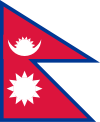
Nepal
- Capital:
- Kathmandu
- Continent:
- Asia
- Region(s):
- Southern Asia, South Central Asia
- Abbreviation:
- NPL

* As of 12/18/2025
1 birth
Every 57.2 seconds
1 death
Every 2.5 minutes
1 emigrant
Every 1.4 minutes
1 person
Every 26.2 minutes
46K
100K
250K
500K
750K
1M
Nepal has a host of ethnicities present. East Asian mixed people, as well as Indo-Aryans, live in the mountains and hilly regions of the country, while Tibetans inhabit the central and western part of Nepal. As a result, Nepal can boast of a multi-ethnic population that also houses a host of different cultures that are shared by its inhabitants.
The languages used in Nepal include Nepali (official) 44.6%, Maithali 11.7%, Bhojpuri 6%, Tharu 5.8%, Tamang 5.1%, Newar 3.2%, Magar 3%, Bajjika 3%, Urdu 2.6%, Avadhi 1.9%, Limbu 1.3%, Gurung 1.2%, other 10.4%, and unspecified at 0.2%.
Chhettri (16.6%)
Brahman-Hill (12.2%)
Magar (7.1%)
Tharu (6.6%)
Tamang (5.8%)
Newar (5%)
Kami (4.8%)
Muslim (4.4%)
Yadav (4%)
Rai (2.3%)
Gurung (2%)
Damai/Dholii (1.8%)
Thakuri (1.6%)
Limbu (1.5%)
Sarki (1.4%)
Teli (1.4%)
Chamar/Harijan/Ram (1.3%)
Koiri/Kushwaha (1.2%)
Other (19%)
The main religion in Nepal is Hindu.
Hindu
Buddhist
Muslim
Kirant
Christian
Other
Unspecified
It also has many different religions present, most significantly Hinduism and Buddhism, but minorities of Muslims and Christians are present as well. The World Factbook gives us a breakdown of Hindu 81.3%, Buddhist 9%, Muslim 4.4%, Kirant 3.1%, Christian 1.4%, other 0.5%, and unspecified faiths 0.2% being practiced among the population from a 2011 estimation.
All of the above factors have also resulted in a lax growth of fundamental institutions such as basic education for everyone in the country. This has resulted in a meager literacy ratehttps://www.cia.gov/library/publications/the-world-factbook/geos/np.html (of those over 15 years of age) of only 63.49% in Nepal, of which 76.4% are males and 53.1% are females. Moreover, life expectancy in Nepal lies at 66.51 years. Specifically, male life expectancy is at 65.26 years, while female life expectancy is at 67.82 years.
Additional factors that influence quality of life can also be considered. This includes the low access to improved sanitation, only at 45.8% of the population. Access to clean drinking water is higher, at 91.6% of the population. In terms of health care, 5.8% of the GDP is spent on the health sector, resulting in a physician density of approximately .6 physicians per 1,000 residents and 3 hospital beds being available per 1,000 residents.
Growth rates were a bit out of control, coming to close to 3% in the latter half of the 20th century, but started to become more manageable around the turn of the century. Causes of the rampant growth have been thought to be a combination of poverty, illiteracy, early marriage, religious beliefs, and growing internal migration.